Active Reading Skills: Effective Strategies and Techniques Essay
VerifiedAdded on 2023/06/12
|6
|1335
|393
Essay
AI Summary
This essay examines the importance of effective reading skills in higher education and focuses on active reading approaches. It defines active reading as a student's full engagement with the material and explores four strategies: creating a shrinking outline, reading with a pencil, creating a preliminary outline, and repeated reading. The essay emphasizes the value of these techniques for reinforcing information, enhancing recall, and improving comprehension. It also includes a personal reflection on the author's reading habits and suggestions for improvement, highlighting the need for note-taking and incorporating reading tactics to become a more active and effective reader. The conclusion reiterates the significance of understanding various reading styles and integrating effective techniques into daily learning.
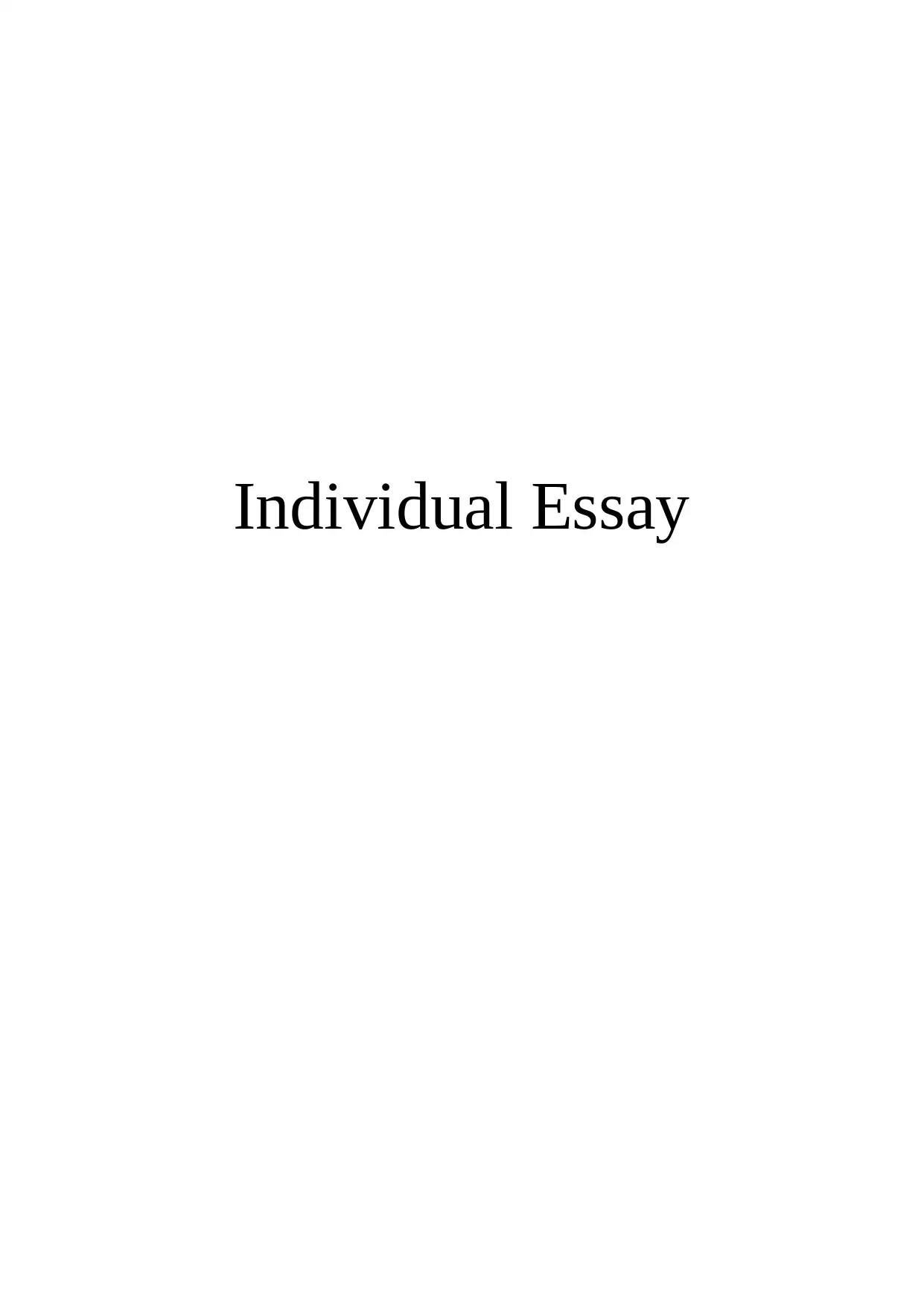
Individual Essay
Paraphrase This Document
Need a fresh take? Get an instant paraphrase of this document with our AI Paraphraser
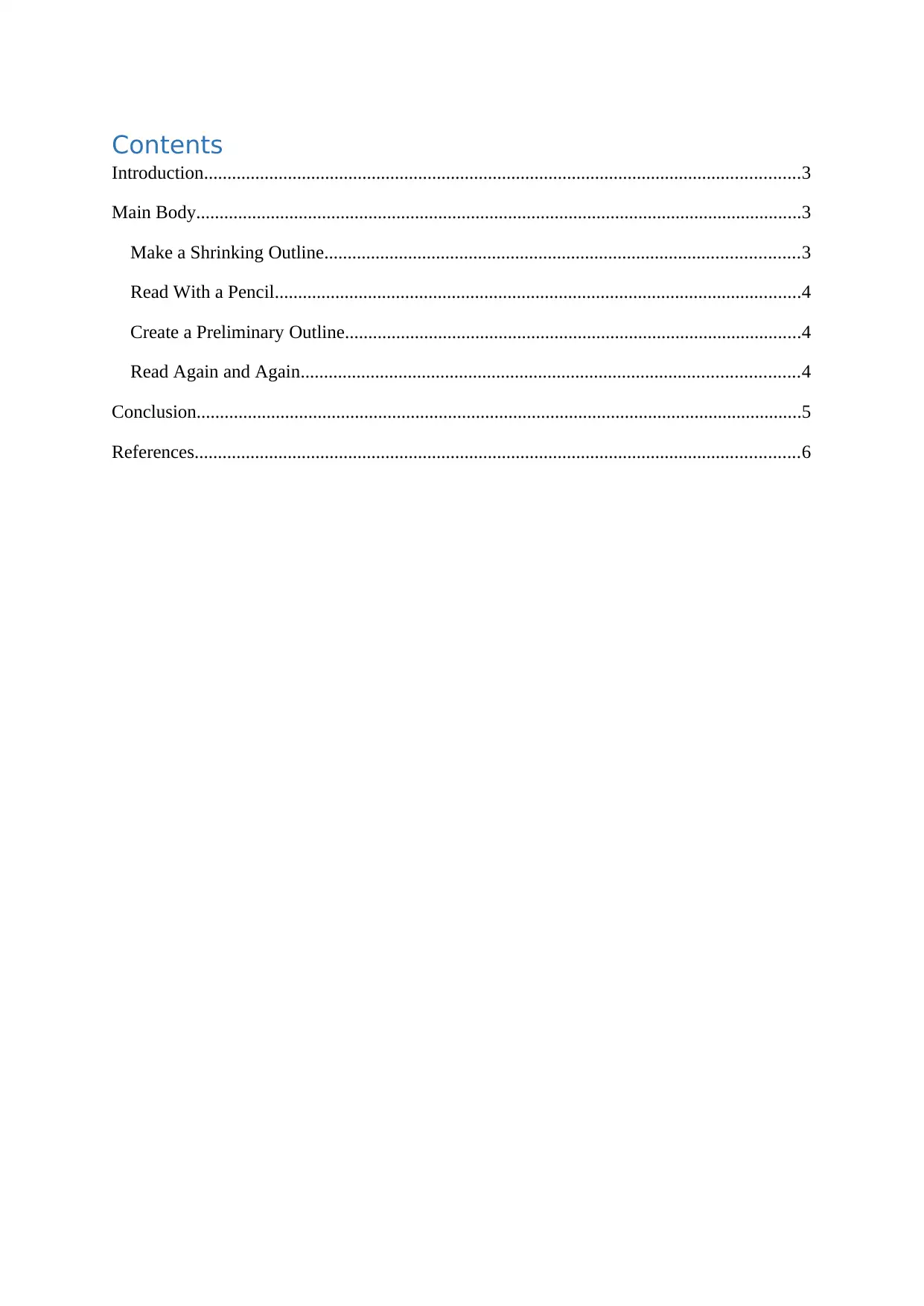
Contents
Introduction................................................................................................................................3
Main Body..................................................................................................................................3
Make a Shrinking Outline......................................................................................................3
Read With a Pencil.................................................................................................................4
Create a Preliminary Outline..................................................................................................4
Read Again and Again...........................................................................................................4
Conclusion..................................................................................................................................5
References..................................................................................................................................6
Introduction................................................................................................................................3
Main Body..................................................................................................................................3
Make a Shrinking Outline......................................................................................................3
Read With a Pencil.................................................................................................................4
Create a Preliminary Outline..................................................................................................4
Read Again and Again...........................................................................................................4
Conclusion..................................................................................................................................5
References..................................................................................................................................6
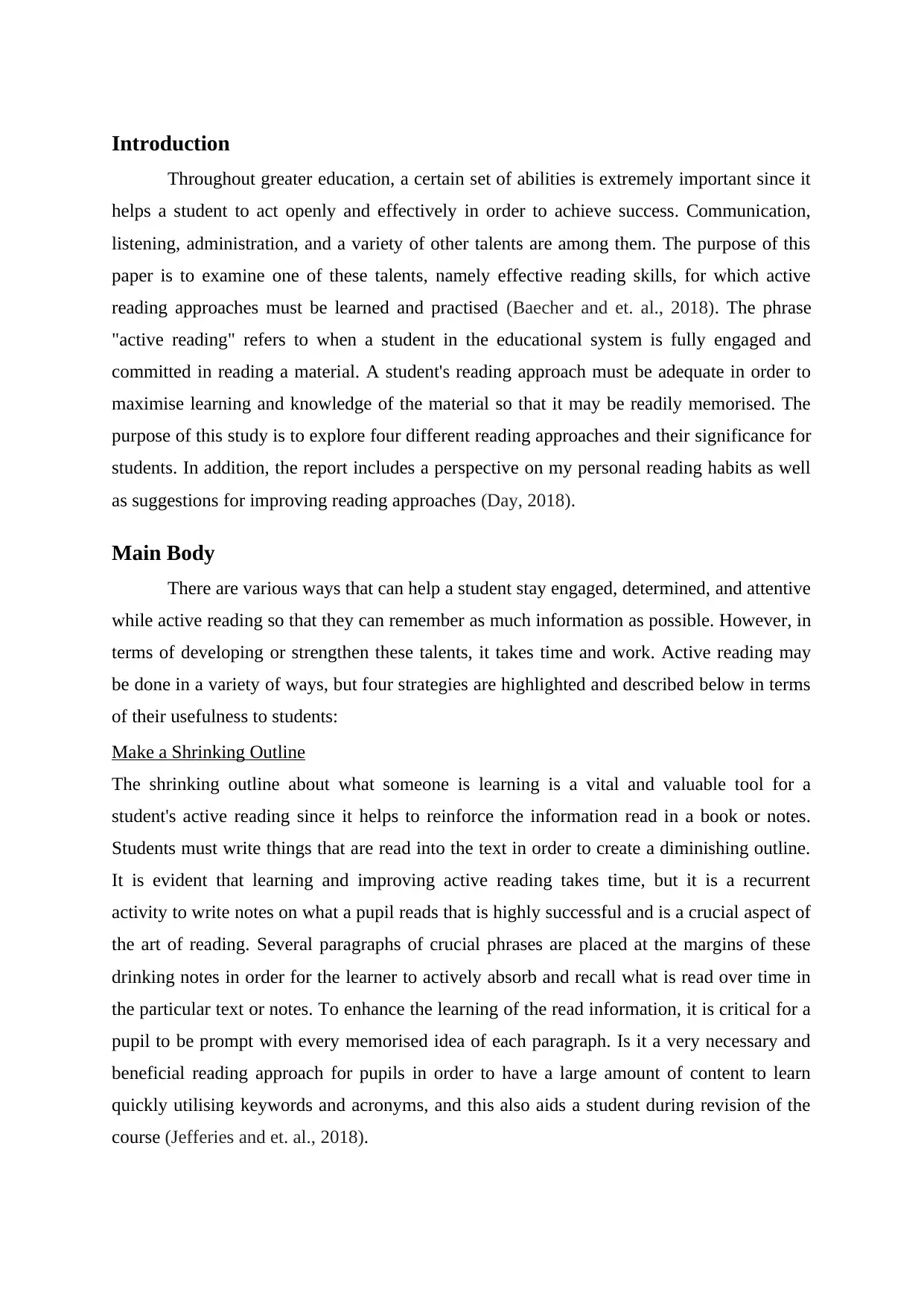
Introduction
Throughout greater education, a certain set of abilities is extremely important since it
helps a student to act openly and effectively in order to achieve success. Communication,
listening, administration, and a variety of other talents are among them. The purpose of this
paper is to examine one of these talents, namely effective reading skills, for which active
reading approaches must be learned and practised (Baecher and et. al., 2018). The phrase
"active reading" refers to when a student in the educational system is fully engaged and
committed in reading a material. A student's reading approach must be adequate in order to
maximise learning and knowledge of the material so that it may be readily memorised. The
purpose of this study is to explore four different reading approaches and their significance for
students. In addition, the report includes a perspective on my personal reading habits as well
as suggestions for improving reading approaches (Day, 2018).
Main Body
There are various ways that can help a student stay engaged, determined, and attentive
while active reading so that they can remember as much information as possible. However, in
terms of developing or strengthen these talents, it takes time and work. Active reading may
be done in a variety of ways, but four strategies are highlighted and described below in terms
of their usefulness to students:
Make a Shrinking Outline
The shrinking outline about what someone is learning is a vital and valuable tool for a
student's active reading since it helps to reinforce the information read in a book or notes.
Students must write things that are read into the text in order to create a diminishing outline.
It is evident that learning and improving active reading takes time, but it is a recurrent
activity to write notes on what a pupil reads that is highly successful and is a crucial aspect of
the art of reading. Several paragraphs of crucial phrases are placed at the margins of these
drinking notes in order for the learner to actively absorb and recall what is read over time in
the particular text or notes. To enhance the learning of the read information, it is critical for a
pupil to be prompt with every memorised idea of each paragraph. Is it a very necessary and
beneficial reading approach for pupils in order to have a large amount of content to learn
quickly utilising keywords and acronyms, and this also aids a student during revision of the
course (Jefferies and et. al., 2018).
Throughout greater education, a certain set of abilities is extremely important since it
helps a student to act openly and effectively in order to achieve success. Communication,
listening, administration, and a variety of other talents are among them. The purpose of this
paper is to examine one of these talents, namely effective reading skills, for which active
reading approaches must be learned and practised (Baecher and et. al., 2018). The phrase
"active reading" refers to when a student in the educational system is fully engaged and
committed in reading a material. A student's reading approach must be adequate in order to
maximise learning and knowledge of the material so that it may be readily memorised. The
purpose of this study is to explore four different reading approaches and their significance for
students. In addition, the report includes a perspective on my personal reading habits as well
as suggestions for improving reading approaches (Day, 2018).
Main Body
There are various ways that can help a student stay engaged, determined, and attentive
while active reading so that they can remember as much information as possible. However, in
terms of developing or strengthen these talents, it takes time and work. Active reading may
be done in a variety of ways, but four strategies are highlighted and described below in terms
of their usefulness to students:
Make a Shrinking Outline
The shrinking outline about what someone is learning is a vital and valuable tool for a
student's active reading since it helps to reinforce the information read in a book or notes.
Students must write things that are read into the text in order to create a diminishing outline.
It is evident that learning and improving active reading takes time, but it is a recurrent
activity to write notes on what a pupil reads that is highly successful and is a crucial aspect of
the art of reading. Several paragraphs of crucial phrases are placed at the margins of these
drinking notes in order for the learner to actively absorb and recall what is read over time in
the particular text or notes. To enhance the learning of the read information, it is critical for a
pupil to be prompt with every memorised idea of each paragraph. Is it a very necessary and
beneficial reading approach for pupils in order to have a large amount of content to learn
quickly utilising keywords and acronyms, and this also aids a student during revision of the
course (Jefferies and et. al., 2018).
⊘ This is a preview!⊘
Do you want full access?
Subscribe today to unlock all pages.

Trusted by 1+ million students worldwide
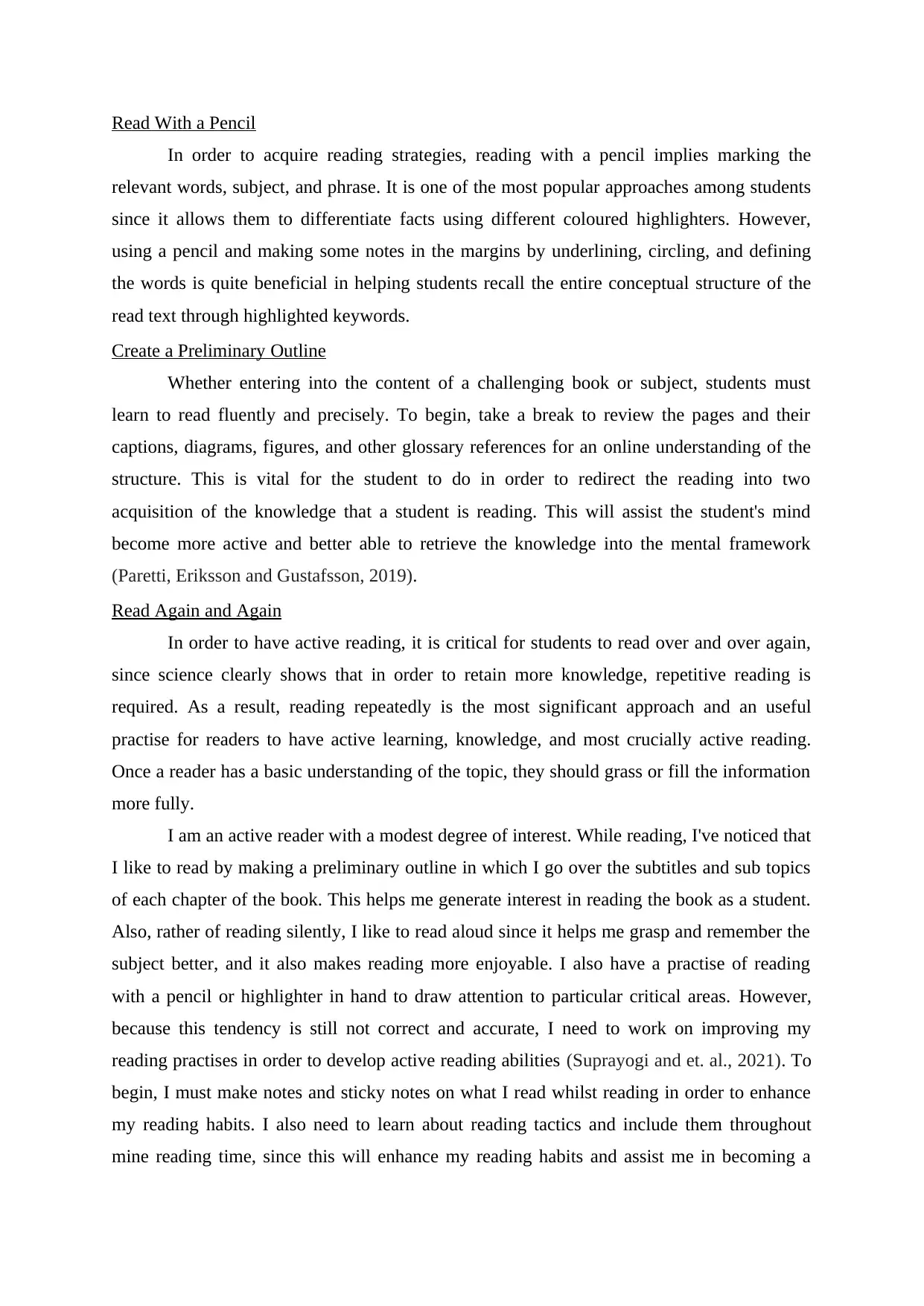
Read With a Pencil
In order to acquire reading strategies, reading with a pencil implies marking the
relevant words, subject, and phrase. It is one of the most popular approaches among students
since it allows them to differentiate facts using different coloured highlighters. However,
using a pencil and making some notes in the margins by underlining, circling, and defining
the words is quite beneficial in helping students recall the entire conceptual structure of the
read text through highlighted keywords.
Create a Preliminary Outline
Whether entering into the content of a challenging book or subject, students must
learn to read fluently and precisely. To begin, take a break to review the pages and their
captions, diagrams, figures, and other glossary references for an online understanding of the
structure. This is vital for the student to do in order to redirect the reading into two
acquisition of the knowledge that a student is reading. This will assist the student's mind
become more active and better able to retrieve the knowledge into the mental framework
(Paretti, Eriksson and Gustafsson, 2019).
Read Again and Again
In order to have active reading, it is critical for students to read over and over again,
since science clearly shows that in order to retain more knowledge, repetitive reading is
required. As a result, reading repeatedly is the most significant approach and an useful
practise for readers to have active learning, knowledge, and most crucially active reading.
Once a reader has a basic understanding of the topic, they should grass or fill the information
more fully.
I am an active reader with a modest degree of interest. While reading, I've noticed that
I like to read by making a preliminary outline in which I go over the subtitles and sub topics
of each chapter of the book. This helps me generate interest in reading the book as a student.
Also, rather of reading silently, I like to read aloud since it helps me grasp and remember the
subject better, and it also makes reading more enjoyable. I also have a practise of reading
with a pencil or highlighter in hand to draw attention to particular critical areas. However,
because this tendency is still not correct and accurate, I need to work on improving my
reading practises in order to develop active reading abilities (Suprayogi and et. al., 2021). To
begin, I must make notes and sticky notes on what I read whilst reading in order to enhance
my reading habits. I also need to learn about reading tactics and include them throughout
mine reading time, since this will enhance my reading habits and assist me in becoming a
In order to acquire reading strategies, reading with a pencil implies marking the
relevant words, subject, and phrase. It is one of the most popular approaches among students
since it allows them to differentiate facts using different coloured highlighters. However,
using a pencil and making some notes in the margins by underlining, circling, and defining
the words is quite beneficial in helping students recall the entire conceptual structure of the
read text through highlighted keywords.
Create a Preliminary Outline
Whether entering into the content of a challenging book or subject, students must
learn to read fluently and precisely. To begin, take a break to review the pages and their
captions, diagrams, figures, and other glossary references for an online understanding of the
structure. This is vital for the student to do in order to redirect the reading into two
acquisition of the knowledge that a student is reading. This will assist the student's mind
become more active and better able to retrieve the knowledge into the mental framework
(Paretti, Eriksson and Gustafsson, 2019).
Read Again and Again
In order to have active reading, it is critical for students to read over and over again,
since science clearly shows that in order to retain more knowledge, repetitive reading is
required. As a result, reading repeatedly is the most significant approach and an useful
practise for readers to have active learning, knowledge, and most crucially active reading.
Once a reader has a basic understanding of the topic, they should grass or fill the information
more fully.
I am an active reader with a modest degree of interest. While reading, I've noticed that
I like to read by making a preliminary outline in which I go over the subtitles and sub topics
of each chapter of the book. This helps me generate interest in reading the book as a student.
Also, rather of reading silently, I like to read aloud since it helps me grasp and remember the
subject better, and it also makes reading more enjoyable. I also have a practise of reading
with a pencil or highlighter in hand to draw attention to particular critical areas. However,
because this tendency is still not correct and accurate, I need to work on improving my
reading practises in order to develop active reading abilities (Suprayogi and et. al., 2021). To
begin, I must make notes and sticky notes on what I read whilst reading in order to enhance
my reading habits. I also need to learn about reading tactics and include them throughout
mine reading time, since this will enhance my reading habits and assist me in becoming a
Paraphrase This Document
Need a fresh take? Get an instant paraphrase of this document with our AI Paraphraser
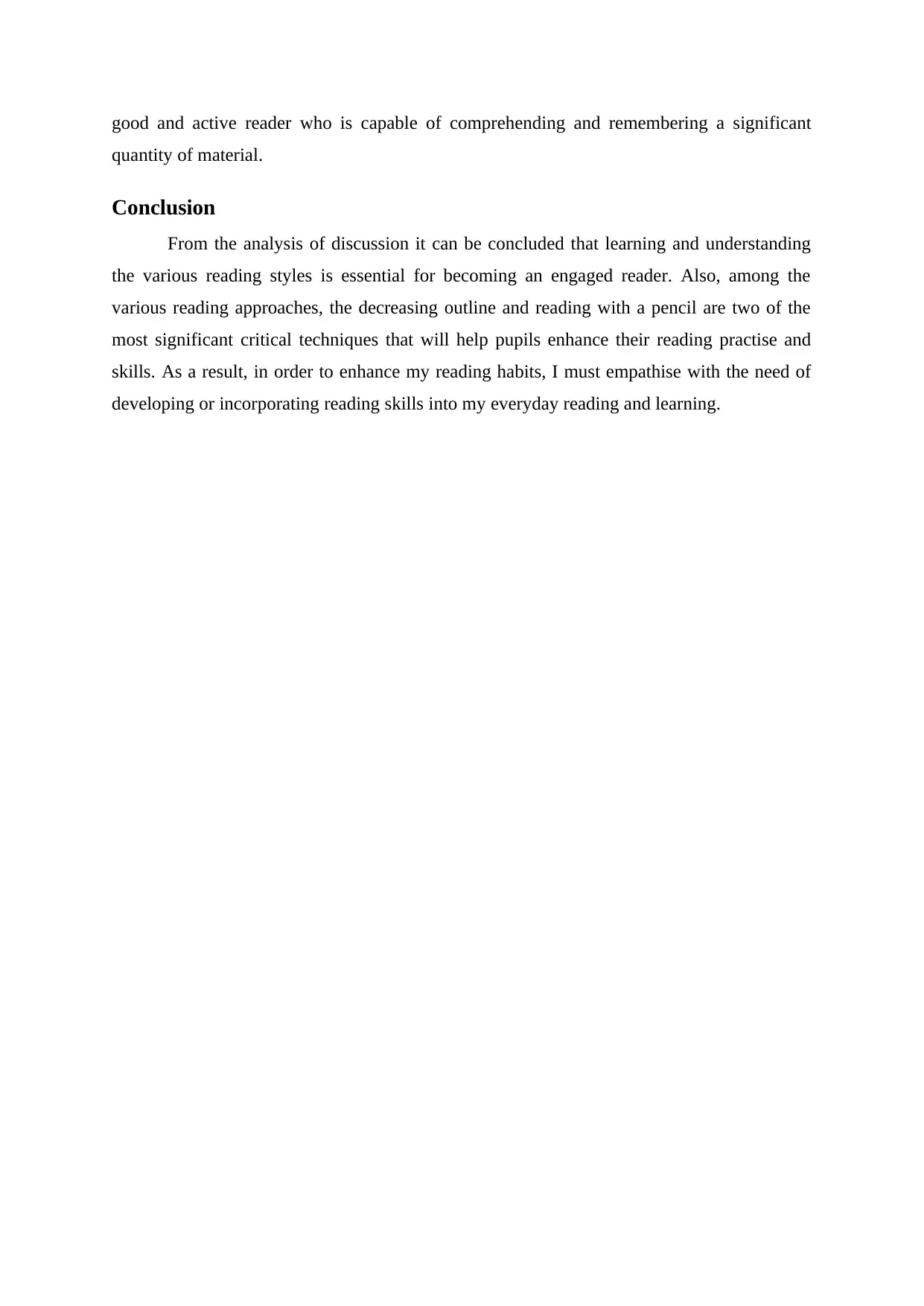
good and active reader who is capable of comprehending and remembering a significant
quantity of material.
Conclusion
From the analysis of discussion it can be concluded that learning and understanding
the various reading styles is essential for becoming an engaged reader. Also, among the
various reading approaches, the decreasing outline and reading with a pencil are two of the
most significant critical techniques that will help pupils enhance their reading practise and
skills. As a result, in order to enhance my reading habits, I must empathise with the need of
developing or incorporating reading skills into my everyday reading and learning.
quantity of material.
Conclusion
From the analysis of discussion it can be concluded that learning and understanding
the various reading styles is essential for becoming an engaged reader. Also, among the
various reading approaches, the decreasing outline and reading with a pencil are two of the
most significant critical techniques that will help pupils enhance their reading practise and
skills. As a result, in order to enhance my reading habits, I must empathise with the need of
developing or incorporating reading skills into my everyday reading and learning.
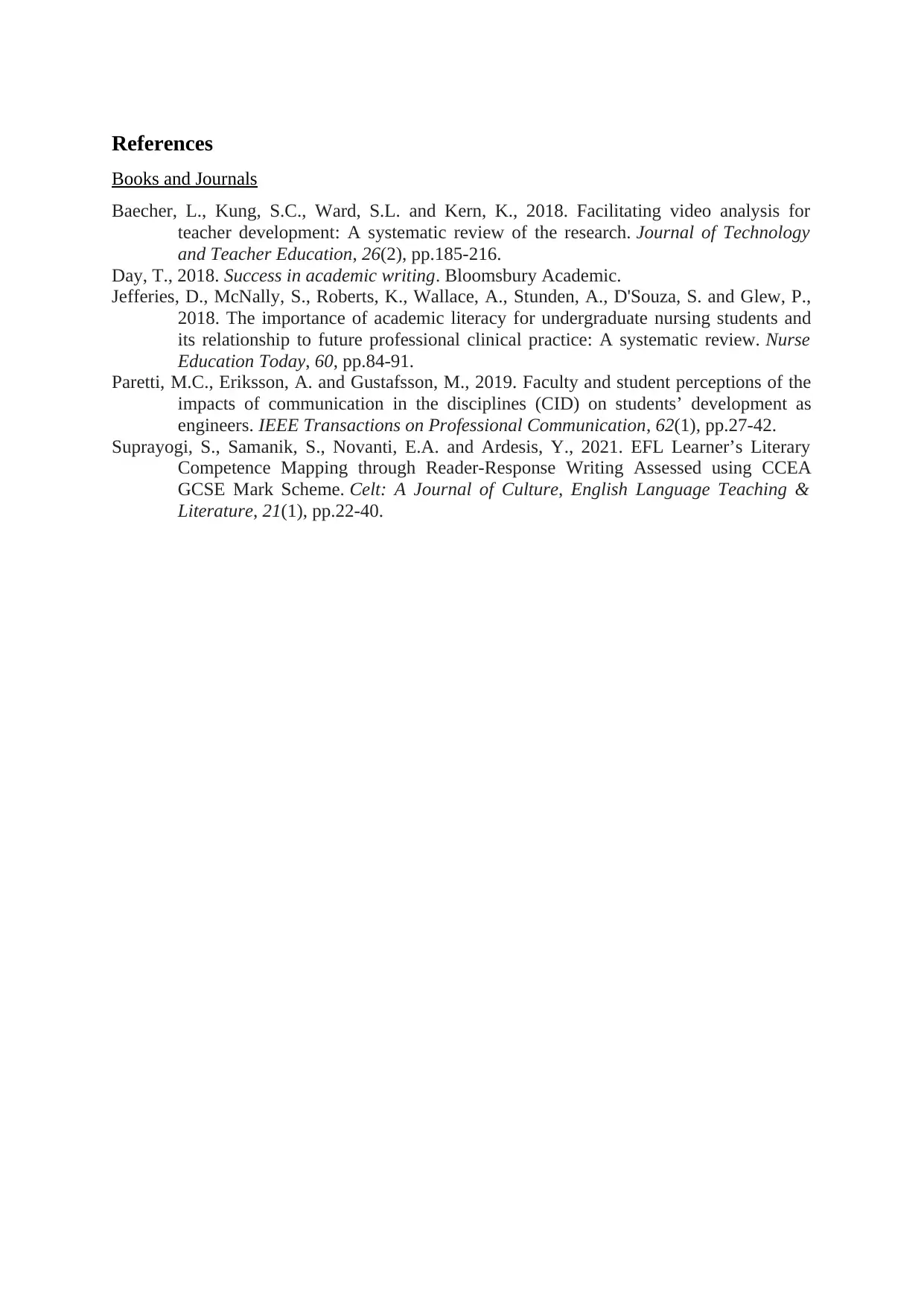
References
Books and Journals
Baecher, L., Kung, S.C., Ward, S.L. and Kern, K., 2018. Facilitating video analysis for
teacher development: A systematic review of the research. Journal of Technology
and Teacher Education, 26(2), pp.185-216.
Day, T., 2018. Success in academic writing. Bloomsbury Academic.
Jefferies, D., McNally, S., Roberts, K., Wallace, A., Stunden, A., D'Souza, S. and Glew, P.,
2018. The importance of academic literacy for undergraduate nursing students and
its relationship to future professional clinical practice: A systematic review. Nurse
Education Today, 60, pp.84-91.
Paretti, M.C., Eriksson, A. and Gustafsson, M., 2019. Faculty and student perceptions of the
impacts of communication in the disciplines (CID) on students’ development as
engineers. IEEE Transactions on Professional Communication, 62(1), pp.27-42.
Suprayogi, S., Samanik, S., Novanti, E.A. and Ardesis, Y., 2021. EFL Learner’s Literary
Competence Mapping through Reader-Response Writing Assessed using CCEA
GCSE Mark Scheme. Celt: A Journal of Culture, English Language Teaching &
Literature, 21(1), pp.22-40.
Books and Journals
Baecher, L., Kung, S.C., Ward, S.L. and Kern, K., 2018. Facilitating video analysis for
teacher development: A systematic review of the research. Journal of Technology
and Teacher Education, 26(2), pp.185-216.
Day, T., 2018. Success in academic writing. Bloomsbury Academic.
Jefferies, D., McNally, S., Roberts, K., Wallace, A., Stunden, A., D'Souza, S. and Glew, P.,
2018. The importance of academic literacy for undergraduate nursing students and
its relationship to future professional clinical practice: A systematic review. Nurse
Education Today, 60, pp.84-91.
Paretti, M.C., Eriksson, A. and Gustafsson, M., 2019. Faculty and student perceptions of the
impacts of communication in the disciplines (CID) on students’ development as
engineers. IEEE Transactions on Professional Communication, 62(1), pp.27-42.
Suprayogi, S., Samanik, S., Novanti, E.A. and Ardesis, Y., 2021. EFL Learner’s Literary
Competence Mapping through Reader-Response Writing Assessed using CCEA
GCSE Mark Scheme. Celt: A Journal of Culture, English Language Teaching &
Literature, 21(1), pp.22-40.
⊘ This is a preview!⊘
Do you want full access?
Subscribe today to unlock all pages.

Trusted by 1+ million students worldwide
1 out of 6
Related Documents
Your All-in-One AI-Powered Toolkit for Academic Success.
+13062052269
info@desklib.com
Available 24*7 on WhatsApp / Email
![[object Object]](/_next/static/media/star-bottom.7253800d.svg)
Unlock your academic potential
Copyright © 2020–2025 A2Z Services. All Rights Reserved. Developed and managed by ZUCOL.


